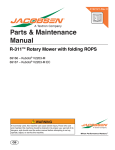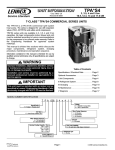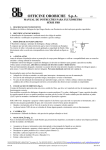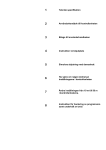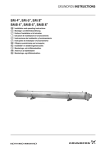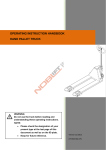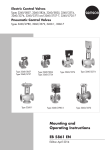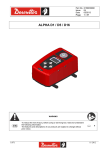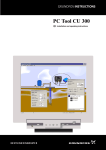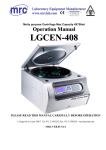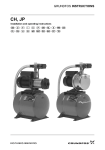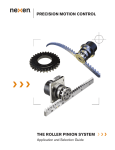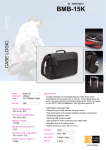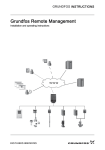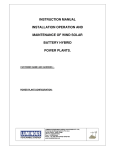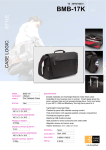Download BM 4", BM 6", BM 8" BMB 4"
Transcript
GRUNDFOS INSTRUCTIONS BM 4", BM 6", BM 8" BMB 4", BMB 6", BMB 8" Installation and operating instructions Declaration of Conformity We, Grundfos, declare under our sole responsibility that the products BM 4", BM 6", BM 8", BMB 4", BMB 6" and BMB 8", to which this declaration relates, are in conformity with these Council directives on the approximation of the laws of the EC member states: — Machinery Directive (2006/42/EC). Standard used: EN 809: 2009. — Low Voltage Directive (2006/95/EC). Standard used: EN 60204-1: 2006. — EMC Directive (2004/108/EC). Standards used: EN 61000-6-2: 2005 and EN 61000-6-3: 2007. Déclaration de Conformité Nous, Grundfos, déclarons sous notre seule responsabilité, que les produits BM 4", BM 6", BM 8", BMB 4", BMB 6" et BMB 8", auxquels se réfère cette déclaration, sont conformes aux Directives du Conseil concernant le rapprochement des législations des Etats membres CE relatives aux normes énoncées ci-dessous : — Directive Machines (2006/42/CE). Norme utilisée : EN 809 : 2009. — Directive Basse Tension (2006/95/CE). Norme utilisée : EN 60204-1: 2006. — Directive Compatibilité Electromagnétique CEM (2004/108/CE). Normes utilisées : EN 61000-6-2 : 2005 et EN 61000-6-3 : 2007. Declaración de Conformidad Nosotros, Grundfos, declaramos bajo nuestra entera responsabilidad que los productos BM 4", BM 6", BM 8", BMB 4", BMB 6" y BMB 8", a los cuales se refiere esta declaración, están conformes con las Directivas del Consejo en la aproximación de las leyes de las Estados Miembros del EM: — Directiva de Maquinaria (2006/42/CE). Norma aplicada: EN 809: 2009. — Directiva de Baja Tensión (2006/95/CE). Norma aplicada: EN 60204-1: 2006. — Directiva EMC (2004/108/CE). Normas aplicadas: EN 61000-6-2: 2005 y EN 61000-6-3: 2007. Δήλωση Συμμόρφωσης Εμείς, η Grundfos, δηλώνουμε με αποκλειστικά δική μας ευθύνη ότι τα προϊόντα BM 4", BM 6", BM 8", BMB 4", BMB 6" και BMB 8" στα οποία αναφέρεται η παρούσα δήλωση, συμμορφώνονται με τις εξής Οδηγίες του Συμβουλίου περί προσέγγισης των νομοθεσιών των κρατών μελών της ΕΕ: — Οδηγία για μηχανήματα (2006/42/EC). Πρότυπο που χρησιμοποιήθηκε: EN 809: 2009. — Οδηγία χαμηλής τάσης (2006/95/EC). Πρότυπο που χρησιμοποιήθηκε: EN 60204-1: 2006. — Οδηγία Ηλεκτρομαγνητικής Συμβατότητας (EMC) (2004/108/EC). Πρότυπα που χρησιμοποιήθηκαν: EN 61000-6-2: 2005 και EN 61000-6-3: 2007. Försäkran om överensstämmelse Vi, Grundfos, försäkrar under ansvar att produkterna BM 4", BM 6", BM 8", BMB 4", BMB 6" och BMB 8", som omfattas av denna försäkran, är i överensstämmelse med rådets direktiv om inbördes närmande till EUmedlemsstaternas lagstiftning, avseende: — Maskindirektivet (2006/42/EG). Tillämpad standard: EN 809: 2009. — Lågspänningsdirektivet (2006/95/EG). Tillämpad standard: EN 60204-1: 2006. — EMC-direktivet (2004/108/EG). Tillämpade standarder: EN 61000-6-2: 2005 och EN 61000-6-3: 2007. Overensstemmelseserklæring Vi, Grundfos, erklærer under ansvar at produkterne BM 4", BM 6", BM 8", BMB 4", BMB 6" og BMB 8" som denne erklæring omhandler, er i overensstemmelse med disse af Rådets direktiver om indbyrdes tilnærmelse til EF-medlemsstaternes lovgivning: — Maskindirektivet (2006/42/EF). Anvendt standard: EN 809: 2009. — Lavspændingsdirektivet (2006/95/EF). Anvendt standard: EN 60204-1: 2006. — EMC-direktivet (2004/108/EF). Anvendte standarder: EN 61000-6-2: 2005: 2005 og EN 61000-6-3: 2007. Konformitätserklärung Wir, Grundfos, erklären in alleiniger Verantwortung, dass die Produkte BM 4", BM 6", BM 8", BMB 4", BMB 6" und BMB 8", auf die sich diese Erklärung bezieht, mit den folgenden Richtlinien des Rates zur Angleichung der Rechtsvorschriften der EU-Mitgliedsstaaten übereinstimmen: — Maschinenrichtlinie (2006/42/EG). Norm, die verwendet wurde: EN 809: 2009. — Niederspannungsrichtlinie (2006/95/EG). Norm, die verwendet wurde: EN 60204-1: 2006. — EMV-Richtlinie (2004/108/EG). Normen, die verwendet wurden: EN 61000-6-2: 2005 und EN 61000-6-3: 2007. Dichiarazione di Conformità Grundfos dichiara sotto la sua esclusiva responsabilità che i prodotti BM 4", BM 6", BM 8", BMB 4", BMB 6" e BMB 8", ai quali si riferisce questa dichiarazione, sono conformi alle seguenti direttive del Consiglio riguardanti il riavvicinamento delle legislazioni degli Stati membri CE: — Direttiva Macchine (2006/42/CE). Norma applicata: EN 809: 2009. — Direttiva Bassa Tensione (2006/95/CE). Norma applicata: EN 60204-1: 2006. — Direttiva EMC (2004/108/CE). Norme applicate: EN 61000-6-2: 2005 e EN 61000-6-3: 2007. Declaração de Conformidade A Grundfos declara sob sua única responsabilidade que os produtos BM 4", BM 6", BM 8", BMB 4", BMB 6" e BMB 8", aos quais diz respeito esta declaração, estão em conformidade com as seguintes Directivas do Conselho sobre a aproximação das legislações dos Estados Membros da CE: — Directiva Máquinas (2006/42/CE). Norma utilizada: EN 809: 2009. — Directiva Baixa Tensão (2006/95/CE). Norma utilizada: EN 60204-1: 2006. — Directiva EMC (compatibilidade electromagnética) (2004/108/CE). Normas utilizadas: EN 61000-6-2: 2005 e EN 61000-6-3: 2007. Overeenkomstigheidsverklaring Wij, Grundfos, verklaren geheel onder eigen verantwoordelijkheid dat de producten BM 4", BM 6", BM 8", BMB 4", BMB 6" en BMB 8" waarop deze verklaring betrekking heeft, in overeenstemming zijn met de Richtlijnen van de Raad in zake de onderlinge aanpassing van de wetgeving van de EG Lidstaten betreffende: — Machine Richtlijn (2006/42/EC). Gebruikte norm: EN 809: 2009. — Laagspannings Richtlijn (2006/95/EC). Gebruikte norm: EN 60204-1: 2006. — EMC Richtlijn (2004/108/EC). Gebruikte normen: EN 61000-6-2: 2005 en EN 61000-6-3: 2007. Vaatimustenmukaisuusvakuutus Me, Grundfos, vakuutamme omalla vastuullamme, että tuotteet BM 4", BM 6", BM 8", BMB 4", BMB 6" ja BMB 8", joita tämä vakuutus koskee, ovat EY:n jäsenvaltioiden lainsäädännön yhdenmukaistamiseen tähtäävien Euroopan neuvoston direktiivien vaatimusten mukaisia seuraavasti: — Konedirektiivi (2006/42/EY). Sovellettu standardi: EN 809: 2009. — Pienjännitedirektiivi (2006/95/EY). Sovellettu standardi: EN 60204-1: 2006. — EMC-direktiivi (2004/108/EY). Sovellettavat standardit: EN 61000-6-2: 2005: 2005 ja EN 61000-6-3: 2007. Bjerringbro, 6th May 2010 Jan Strandgaard Technical Director Grundfos Holding A/S Poul Due Jensens Vej 7 8850 Bjerringbro, Denmark Person authorised to compile technical file and empowered to sign the EC declaration of conformity. 2 BM 4", BM 6", BM 8" BMB 4", BMB 6", BMB 8" Installation and operating instructions 4 Montage- und Betriebsanleitung 12 Notice d'installation et d'entretien 21 Istruzioni di installazione e funzionamento 29 Instrucciones de instalación y funcionamiento 37 Instruções de instalação e funcionamento 45 Οδηγίες εγκατάστασης και λειτουργίας 53 Installatie- en bedieningsinstructies 61 Monterings- och driftsinstruktion 69 Asennus- ja käyttöohjeet 77 Monterings- og driftsinstruktion 85 3 Original installation and operating instructions. CONTENTS Page Allowed General description Pumped liquids Sound pressure level 4 4 4 2. 2.1 Delivery, transportation and storage Frost protection 4 4 3. Preparation 4 4. 4.1 Installation Booster modules connected in series and in parallel 5 5 5. Pipe connection 6 6. 6.1 Electrical connection Frequency converter operation 6 7 7. 7.1 Motor protection Setting of motor starter 7 7 Note: If the module has been stored for more than one year, the motor liquid must be checked and refilled, if required. 8. Before starting the booster module(s) 7 9. 9.1 Operation Limitations to operation 8 8 Motors of standard modules are factory-filled with a Grundfos motor liquid, SML-2, which is frost-proof down to –20°C. 10. Automatic monitoring devices 9 Motors of modules in special version may be filled with demineralized water, i.e. not frost-proof. 9 2.1 Frost protection 11. Checking of operation 12. Fault finding chart 10 13. Manuals 10 14. Checking of motor and cable 11 15. Disposal 11 Not allowed TM01 1282 4197 1. 1.1 1.2 Fig. 1 If the module has to be stored, it must be stored on a frost-free location, or it must be ensured that the motor liquid is frost-proof. 3. Preparation Before installation, the following checks should be made: Before beginning installation procedures, these installation and operating instructions should be studied carefully. The installation and operation should also be in accordance with local regulations and accepted codes of good practice. 1. General description Grundfos BM and BMB booster modules are designed for pressure boosting, liquid transfer and circulation in systems with a high static pressure. 1.1 Pumped liquids Thin, non-explosive liquids, not containing abrasive particles or fibres. The liquid must not attack the pump materials chemically and mechanically. The booster modules must not be used for the pumping of inflammable liquids such as diesel oil, petrol or similar liquids. 1. Check for transport damages Make sure that the module has not been damaged during transportation. 2. Type of module Check that the type designation given on the nameplate fitted to the sleeve corresponds to order. 3. Electricity supply The motor voltage and frequency are marked on the nameplate. Make sure that the motor is suitable for the electricity supply on which it will be used. 4. Liquid in motor If a module has been stored for more than one year, check the motor liquid and refill, if required. Contact Grundfos. If a module is supplied for a special system, the motor may be supplied without liquid or with demineralized water. See section 2. Delivery, transportation and storage. Versions: BM 4" Straight version TM00 3793 4698 1.2 Sound pressure level The sound pressure level of the booster modules BM 4", BM 6", BMB 4" and BMB 6" is lower than 70 dB(A). The sound pressure level of the booster modules BM 8" and BMB 8" is lower than 80 dB(A). TM00 3794 4698 Bent version Delivery: The booster modules are supplied from the factory in proper packing in which they should remain until they are to be installed. The modules are ready for installation. Transportation and storage: During transportation and storage, the booster modules may only be placed in the positions shown in fig. 1. Before storage, the booster modules should be flushed through with clean freshwater, see section 9.1.2 Flushing of the booster module. 4 BM 6" BM 6" is only available in straight version. TM00 4019 4698 2. Delivery, transportation and storage BM 8" BM 8" is only available in straight version. BMB 4" Not allowed Straight version TM01 1282 4197 TM01 1420 4698 Allowed TM01 9711 3800 Fig. 3 L Bent version 3/7 L 2/7 L TM02 5911 4002 / TM00 4041 4197 TM01 9712 3800 2/7 L BMB 6" TM01 9713 2700 BMB 6" is only available in straight version. Fig. 4 BMB 8" 4.1 Booster modules connected in series and in parallel • For modules connected in series, mounted above each other, it is recommended to connect the pipes as shown in fig. 5. • For modules connected in parallel, mounted above each other, it is recommended to connect the pipes as shown in fig. 6. This layout ensures that the modules are filled with water before starting. • When modules are connected in series and parallel, mounted above each other, it is recommended to connect the pipes as shown in fig. 7. • For modules connected in series and fitted with a bypass, mounted above each other, it is recommended to connect the pipes as shown in fig. 8. Fig. 2 4. Installation Grundfos booster modules are supplied as standard without builtin non-return valve, but they are available with non-return valve. For the application of a non-return valve, see fig. 6. In systems involving the risk of water hammer in connection with start/stop, the necessary measures must be taken to reduce this risk. Bypass Bypass The booster modules are suitable for both vertical and horizontal installation, however, the discharge port should never fall below the horizontal plane, see fig. 3. 4 An arrow on the module sleeve shows the direction of flow of liquid through the module, see fig. 2. 3 The module is fastened by means of clamps, see fig. 4. 2 Note that the module has an uneven weight distribution. Because of the motor, the largest weight will be in the first third of the sleeve (when seen from the suction port). 1 Fig. 5 TM00 3760 1902 TM01 9714 2700 BMB 8" is only available in straight version. Booster system with four modules connected in series, mounted above each other. 5 5. Pipe connection The booster modules are fitted with clamp liners for Victaulic/PJE clamp couplings on the suction and discharge sides, see fig. 9. Bypass Bypass 4 Bypass Bypass 3 Bypass Bypass TM00 3761 1902 1 Fig. 6 Gap Pipe system Booster system with four modules connected in parallel, mounted above each other. Clamp liners Booster module TM01 1066 3597 2 Bypass Bypass Fig. 9 Bypass Bypass Size Type Victaulic coupling Gap [mm] 4 3 TM00 3762 1902 Bypass Bypass 2 1 Fig. 7 Booster system with two modules connected in series and in parallel, mounted above each other. Bypass Bypass BM 4" BM 3A - BM 8A 1¼" ø42 mm 1 BM 6" BM 17 - BM 60 3" ø89 mm 3 BM 8" BM 30 - BM 46 3" ø89 mm 3 BM 8" BM 60 4" ø114 mm 6 BM 8" BM 77 - BM 95 5" ø139 mm 6 BM 8" BM 125 6" ø168 mm 6 BMB 4" BMB 3A - BMB 8A 1¼" ø42 mm 1 BMB 6" BMB 17 - BMB 60 3" ø89 mm 3 BMB 8" BMB 30 - BMB 46 3" ø89 mm 3 BMB 8" BMB 60 4" ø114 mm 6 BMB 8" BMB 77 - BMB 95 5" ø139 mm 6 BMB 8" BMB 125 6" ø168 mm 6 4 6. Electrical connection TM00 3763 1902 3 2 1 The electrical connection should be carried out by an authorized electrician in accordance with local regulations. Before making any electrical connections, make sure that the electricity supply has been switched off and that it cannot be accidentally switched on. The booster modules must be connected to an external mains switch. = Air escape valve Air escape valve = Isolating valve valve Closing = Non-return valve valve Non return Pressure = Pressure switch switch = FlowFlow switchswitch It must be checked that there is voltage symmetry in the electricity supply lines, i.e. approximately same difference of voltage between the individual phases. See also section 14. Checking of motor and cable, point 1. gauge = Motor-operated valve Motor operated valve = Diaphragm tank Diaphragm tank Fig. 8 In order that the modules meet the EC EMC Directive (89/336/ EEC), a 0.47 µF capacitor (in accordance with IEC 384-14) must always be connected over the two phases to which the temperature transmitter is connected, see fig. 10. 0,47 µF Booster system with four modules connected in series with bypass, mounted above each other. RD YE BK Note: As venting problems may arise in such installations, it is advisable to install suitable air vent devices. RD = Red YE = Yellow BK = Black Fig. 10 6 BM/BMB TM02 5255 2402 = Pressure gauge Pressure The pump must be earthed. The required voltage quality measured at the module terminals is –10%/+6% of the nominal voltage during continuous operation (including variation in the supply voltage and losses in cables). TM02 02 5256 2402 The electrical connections must be made close to the flange (fig. 11), either by means of a terminal box (figs. 12 and 13) or a cable termination kit. BM/BMB Fig. 11 Depending on the frequency converter type, it may expose the motor to detrimental voltage peaks. The above disturbance can be abated by installing an RC filter between the frequency converter and the motor. Possible increased acoustic noise from the motor can be abated by installing an LC filter which will also eliminate voltage peaks from the frequency converter. For further details, please contact your frequency converter supplier or Grundfos. 7. Motor protection The booster module must be connected to an effective motor starter which must protect the motor against damage from voltage drop, phase failure, overload and a locked rotor. BM 4", BM 6", BM 8", BMB 4", BMB 6" and BMB 8" Direct-on-line L1 Red Red :V L2 M Yellow Yellow:W BK = Black RD = Red YE = Yellow L3 The control circuit must always be made in such a way that all modules are stopped if one module fails. TM00 4035 1694 Black :U Black In electricity supply systems where undervoltage and variations in phase symmetry may occur, a phase failure relay should also be fitted, see section 14. Checking of motor and cable. S U P P L Y 7.1 Setting of motor starter For cold motors, the tripping time for the motor starter must be less than 10 seconds (Class 10) at 5 times the rated full-load current (I1/1/ISFA) of the module, see the module nameplate. Note: If this requirement is not met, the motor warranty will be invalidated. Fig. 12 In order to ensure the optimum protection of the submersible motor, the starter overload unit should be set in accordance with the following guidelines: BM 6", BM 8", BMB 6" and BMB 8" Star-delta starting 1. Set the starter overload to the rated full-load current (I1/1/ISFA) of the module. S U P P L Y W2 B2 V2 R2 2. Start the module and let it run for half an hour at normal performance, see section 8. Before starting the booster module(s). U2 Y2 3. Slowly grade down the scale indicator until the motor trip point is reached. F O R W1 R1 Y1 U1 B1 BK = Black B=Black, R=Red, RD = Red YE = Yellow 4. Increase the overload setting by 5%. The highest permissible setting is the rated full-load current (I1/1/ISFA) of the module. Y=Yellow TM00 4034 3197 V1 M Fig. 13 For modules wound for star-delta starting, the starter overload unit should be set as above, but the maximum setting should be as follows: Starter overload setting = Rated full-load current x 0.58. The highest permissible start-up time for star-delta starting is 2 seconds. 8. Before starting the booster module(s) 6.1 Frequency converter operation The booster module(s) must be filled with water before start-up. Grundfos motors: Procedure: Three-phase Grundfos MS motors can be connected to a frequency converter. 1. Slacken the vent valve of the booster module, if any. If a frequency converter is to be used for booster modules connected in series, it must be connected to the last module in the flow direction. 3. Completely open the isolating valve. Note: If a Grundfos MS motor with a temperature transmitter is connected to a frequency converter, a fuse incorporated in the transmitter will melt and the transmitter will be inactive. The transmitter cannot be reactivated. This means that the motor will operate like a motor without a temperature transmitter. 2. Ensure an inlet pressure on the booster module. 4. Wait 3 to 5 minutes to ensure optimum venting. 5. Tighten the vent valve. Checking the direction of rotation: Procedure: 1. Close the isolating valve on the discharge side of module 1 (figs. 5 to 8) to approx. 1/3 of maximum flow. During frequency converter operation, it is not advisable to run the motor at a frequency higher than the nominal frequency (50 or 60 Hz). In connection with pump operation, it is important never to reduce the frequency (and consequently the speed) to such a level that the necessary flow of cooling liquid past the motor is no longer ensured. 2. Start module 1 and record discharge pressure and flow readings. The permissible frequency ranges are 30-50 Hz and 30-60 Hz, respectively. 5. Stop the module. During start, the maximum acceleration time from 0 to 30 Hz is 1 second. During stop, the maximum deceleration time from 30 to 0 Hz is 1 second. 3. Stop the module and interchange two of the phases to the module. 4. Restart the module and re-record discharge pressure and flow readings. 6. Compare the results taken under points 2 and 4. The connection which gave the larger pressure and flow is the correct direction of rotation. 7 The check for the direction of rotation should last for the shortest possible time. If the booster system has several modules, starting and rotation checks are made in the order 1-2-3-4 until all modules are running. When module 2 is checked, module 1 must be running. When module 3 is checked, modules 1 and 2 must be running, etc. 9.1 Limitations to operation The flow limits stated in the following table apply to the optimum operating ranges of the modules as regards efficiency: Recommended flows at 25°C (77°F) m³/h If modules in series are also connected in parallel (fig. 7), the direction of rotation of each section connected in series should be checked. After having checked the direction of rotation, stop the modules in the order 4-3-2-1. The booster system is now ready for operation. 9. Operation Start: The booster modules are not allowed to run against a closed discharge valve for more than 5 seconds as this will cause an increase in temperature/formation of steam in the module which may cause damage to the pump and the motor. If there is any danger of the modules running against a closed discharge valve, a minimum liquid flow through the module should be ensured by connecting a bypass/a drain to the discharge side of the module. The drain can for instance be connected to a tank. US GPM Type 50 Hz 60 Hz 50 Hz 60 Hz BM 3A/BMB 3A 0.8-4.4 1.0-5.4 3.5-17.6 4.4-23.8 BM 5A/BMB 5A 2.5-6.8 3.0-8.4 11-30 13-37 BM 8A/BMB 8A 4.0-10 4.8-10 17.6-40 21-40 BM 17/BMB 17 8.0-24 8.0-29 35-106 35-128 BM 30/BMB 30 15-38 18-45 66-167 79-198 BM 46/BMB 46 24-60 28-72 106-264 123-317 BM 60/BMB 60 35-75 40-90 154-330 176-396 BM 77/BMB 77 40-100 48-120 176-440 211-528 BM 95/BMB 95 50-120 60-140 220-528 264-616 BM 125/BMB 125 70-160 80-180 308-704 352-792 The relative pressure limits stated in the following table must be observed: Permissible relative pressures1) Inlet pressure The booster modules must be started in the order 1-2-3-4 at intervals of 1 or 2 seconds, see section 4.1 Booster modules connected in series and in parallel. If other intervals are required, contact Grundfos. Size Outlet pressure Max.2) Min. [bar] [p.s.i.] [bar] [p.s.i.] Module 1 is always the first module on the suction side. During start-up, it is recommended to close the isolating valve ¾ and open it slowly (2 to 3 seconds). In systems involving the risk of water hammer in connection with start/stop, the necessary measures must be taken to reduce this risk, e.g. by installing a diaphragm tank. Max.2) [bar] [p.s.i.] 1160 BM 4" 0.5 7.25 60 870 80 BM 6" 0.5 7.25 50 725 80 1160 BM 8" 1 14.5 25 362 70 1015 BMB 4" 0.5 7.25 30 435 60 870 BMB 6" 0.5 7.25 20 290 50 725 BMB 8" 1 14.5 10 145 45 653 Operation: During operation, the inlet pressure must be checked in accordance with section 9.1 Limitations to operation. The total pressure and flow of modules connected in series should never be changed by stopping one or more of the modules. If different pressures or flows are required, the following procedures are applicable: 1) Contact Grundfos if higher pressures are required. 2) Note: If the maximum inlet/outlet pressure is exceeded, install a safety valve. 9.1.1 Cooling The temperature and flow limits stated in the following table must be observed to ensure sufficient cooling of the motor: 1. Bypass of module(s): Install a bypass between two modules, see fig. 8. Stop the module(s) which is/are not required and close the isolating valves on either side of the module. See section 9.1.2 Flushing of the booster module. The module(s) to be bypassed is/are always the last module(s) in the flow direction. Maximum permissible liquid temperature Motor 2. Fit a reducting valve to the discharge pipe. The values stated in section 9.1 Limitations to operation must be observed. 3. Modules with three-phase motors: Install a frequency converter for speed control of the last booster module in the flow direction, see section 6.1 Frequency converter operation. Stop: Maximum liquid temperature Minimum flow velocity past the motor Minimum flow °C °F m/s (ft/s) m³/h (US GPM) Grundfos 4" 40 104 ≥ 0.15 (0.49) ≥ 0.8 (3.5) Grundfos 6" 40 104 ≥ 0.15 (0.49) ≥ 5.5 (24) FRANKLIN 8" 30 86 ≥ 0.16 (0.52) ≥ 18.5 (81.5) 9.1.2 Flushing of the booster module The modules must be stopped in reverse order, i.e. 4-3-2-1, at intervals of 1 to 2 seconds, see section 4.1 Booster modules connected in series and in parallel. When a module is flushed, the flow must be reduced to maximum 10% of the nominal flow at a minimum pressure of 2 bar. The modules must be stopped while the system is flushed, see section 9. Operation. If the booster system is taken out of operation for a long period, the modules should be flushed through with clean freshwater, see section 9.1.2 Flushing of the booster module. The modules are then left with freshwater until they are to be used again. Note: When pumping water with a salt concentration > 2000 ppm NaCl, the module must be flushed through in the flow direction as described below. 8 The flushing procedure depends on the operating condition: • Intermittent operation: If the module has to be stopped for more than 30 minutes, it must be flushed through with clean freshwater. • Continuous operation: Once every 24 hours, the module should be stopped and flushed through with raw water by means of the feed pump. 9.1.3 Frequency of starts and stops Minimum 1 per year is recommended. Maximum 20 per hour. Maximum 100 per day. Note: BM/BMB 8": Maximum 10 per day. 10. Automatic monitoring devices To protect the modules against dry running and to ensure a minimum flow of cooling water past the motors, the system must be fitted with flow and pressure monitoring devices (figs. 5 to 8). A pressure switch on the suction side is dimensioned in accordance with the estimated inlet pressure. At a pressure lower than 0.5 bar for BM 4", BM 6", BMB 4" and BMB 6" and 1 bar for BM 8" and BMB 8", an alarm is given and the module must be stopped without delay. All discharge connections to the system should be fitted with flow switches which will stop the system at the set minimum flows. The above monitoring devices ensure a correct inlet pressure and a minimum flow of cooling water past the motor. If the modules are stopped automatically, automatic flushing is recommended, see section 9.1.2 Flushing of the booster module. 11. Checking of operation Depending on the number of operating hours of the modules, the following should be checked at suitable intervals: • Flow. • Starting frequency. • Control and protective devices. • Liquid temperature. • Minimum flow through modules during operation. If any of the above checks reveal any abnormal operating details, inspection should be carried out in accordance with the fault finding chart. It is recommended to use the log book at the end of these instructions. 9 12. Fault finding chart Before removing the terminal box cover and before any removal/dismantling of the module, make sure that the electricity supply has been switched off and that it cannot be accidentally switched on. Fault Cause Remedy 1. The booster system stops occasionally. One or more modules stop. a) No or insufficient water supply. The pressure switch has cut out. Check that the pressure switch functions normally (without delay) and is adjusted correctly. Check that the minimum inlet pressure is correct. b) The capacity is too small. The flow switch has cut out. The discharge pipe is totally or partly blocked due to incorrectly adjusted manually operated valve, or failure in the magnetic or motor-operated valve. Check these valves. The flow switch is faulty or incorrectly adjusted. Check/adjust the switch. a) The fuses are blown. Check and replace both main fuses and/or fuses for control circuit. b) The motor starter overload unit has tripped out. Reset the starter overload. If it trips out again, the voltage should be checked. c) The magnetic coil of motor starter/contactor is short-circuited (not cutting in). Replace the coil. Check the coil voltage. d) The control circuit has cut out or is defective. Check the control circuit and the contacts in the monitoring devices (pressure switch, flow switch, etc.). e) The motor/supply cable is defective. Check motor and cable. See also section 14. Checking of motor and cable. a) No water or too small quantity delivered to the modules or air in the system. Check that the inlet pressure during operation is at least 0.5 bar for BM 4", BM 6", BMB 4" and BMB 6" and 1 bar for BM 8" and BMB 8". If so, the water supply is OK. Stop and vent the system. Restart the system as described in section 9. Operation. 2. The booster system does not run. 3. The booster system runs, but gives no water or develops no pressure. If the module is defective, it should be dismantled and repaired/ replaced. 4. The booster system runs at reduced capacity (flow and pressure). b) Suction parts are blocked. Pull the pump out of the sleeve and clean the suction parts. a) Wrong direction of rotation. See section 8. Before starting the booster module(s). b) The valves on the discharge side are partly closed or blocked. Check valves. c) The discharge pipe is partly blocked by impurities. Measure the discharge pressure and compare with the calculated data. Clean or replace the discharge pipe. d) The module is partly blocked by impurities. Pull the pump out of the sleeve. Dismantle, clean and check the pump. Any defective parts should be replaced. Clean the pipes. e) The module is defective. 13. Manuals For the replacement and repair of parts of the booster system, please refer to: Related documentation Service Manual for Replacement of Motor Cable and Motor (4", 6" and 8"). Parts Lists with instructions for dismantling and assembly of pump and motor. www.grundfos.com/xxx 10 Pull the pump out of the sleeve. Dismantle, clean and check the pump. Any defective parts should be replaced. See section 13. Manuals. 14. Checking of motor and cable 1. Supply voltage Measure the voltage between the phases by means of a voltmeter. TM00 1371 5092 Connect the voltmeter to the terminals in the motor starter. The voltage should, when the motor is loaded, be within –10%/+6% of the rated voltage. The motor may burn if there are larger variations in voltage. If the voltage is constantly too high or too low, the motor must be replaced by one corresponding to the supply voltage. Large variations in voltage indicate poor electricity supply, and the module should be stopped until the defect has been found. Resetting of the motor starter may be necessary. Voltmeter 2. Current consumption Measure the current of each phase while the module is operating at a constant discharge pressure (if possible at the capacity where the motor is most heavily loaded). For normal operating current, see nameplate. Calculate the current unbalance (%) in the three phases as follows: 1. Add up the three phase currents. 2. Divide this value by three to ascertain the average current. 3. Find the phase current differing most from the average current. 4. Compare the results from points 2 and 3. 5. Divide the difference by the average value and multiply by 100. The result is the current unbalance in %. TM00 1372 5092 For three-phase motors, the current unbalance must not exceed 5%. If so, or if the current exceeds the maximum operating current, there are the following possible faults: • The contacts of the motor starter are burnt. Replace the contacts. • Poor connection in leads, possibly in terminal box. Ammeter • Too high or too low supply voltage, see point 1. • The motor windings are short-circuited or partly disjointed, see point 3. • Damaged pump is causing the motor to be overloaded. Pull the pump out of the sleeve for overhaul. • The resistance value of the motor windings deviates too much. Move the phases in phase order to a more uniform load. If this does not help, see point 3. Items 3 and 4: Measurement not needed if supply voltage and current consumption are normal. 3. Winding resistance Remove the phase leads from the terminal box. TM00 1373 5092 Measure the winding resistance as shown on the drawing. The highest value must not exceed the lowest value by more than 10%. If the deviation is higher, the pump should be pulled out. Measure motor and cable separately and replace or repair defective parts. See section 13. Manuals. Ohmmeter TM00 1374 5092 4. Insulation resistance Remove the phase leads from the terminal box. Measure the insulation resistance from each phase to earth (frame). (Make sure that the earth connection is made carefully.) If the measured insulation resistance is less than 0.5 megohms and the supply cable is OK, the pump should be pulled out for motor or cable repair or replacement. See section 13. Manuals. Megohmmeter 15. Disposal Disposal of this product or parts of it must be carried out according to the following guidelines: 1. Use the local public or private waste collection service. 2. In case such waste collection service does not exist or cannot handle the materials used in the product, please deliver the product or any hazardous materials form it to your nearest Grundfos company or service workshop. Subject to alterations. 11 LOG BOOK for BM/BMB booster modules Product No: Installation date: Company/your ref. Country: Type: Start of operation: City: VFD/Softstart. Date Amb. temp. Liquid temp. Flow/ pressure Current [A] Voltage [V] Brand Comments 93 System sketch 94 Argentina Bombas GRUNDFOS de Argentina S.A. Ruta Panamericana km. 37.500 Lote 34A 1619 - Garin Pcia. de Buenos Aires Phone: +54-3327 414 444 Telefax: +54-3327 411 111 Australia GRUNDFOS Pumps Pty. Ltd. P.O. Box 2040 Regency Park South Australia 5942 Phone: +61-8-8461-4611 Telefax: +61-8-8340 0155 Austria GRUNDFOS Pumpen Vertrieb Ges.m.b.H. Grundfosstraße 2 A-5082 Grödig/Salzburg Tel.: +43-6246-883-0 Telefax: +43-6246-883-30 Belgium N.V. GRUNDFOS Bellux S.A. Boomsesteenweg 81-83 B-2630 Aartselaar Tél.: +32-3-870 7300 Télécopie: +32-3-870 7301 Belorussia Представительство ГРУНДФОС в Минске 220123, Минск, ул. В. Хоружей, 22, оф. 1105 Тел.: +(37517) 233 97 65, Факс: +(37517) 233 97 69 E-mail: [email protected] Bosnia/Herzegovina GRUNDFOS Sarajevo Trg Heroja 16, BiH-71000 Sarajevo Phone: +387 33 713 290 Telefax: +387 33 659 079 e-mail: [email protected] Brazil BOMBAS GRUNDFOS DO BRASIL Av. Humberto de Alencar Castelo Branco, 630 CEP 09850 - 300 São Bernardo do Campo - SP Phone: +55-11 4393 5533 Telefax: +55-11 4343 5015 Bulgaria GRUNDFOS Pumpen Vertrieb Representative Office - Bulgaria Bulgaria, 1421 Sofia Lozenetz District 105-107 Arsenalski blvd. Phone: +359 2963 3820, 2963 5653 Telefax: +359 2963 1305 Canada GRUNDFOS Canada Inc. 2941 Brighton Road Oakville, Ontario L6H 6C9 Phone: +1-905 829 9533 Telefax: +1-905 829 9512 China GRUNDFOS Pumps (Shanghai) Co. Ltd. 51 Floor, Raffles City No. 268 Xi Zang Road. (M) Shanghai 200001 PRC Phone: +86-021-612 252 22 Telefax: +86-021-612 253 33 Croatia GRUNDFOS CROATIA d.o.o. Cebini 37, Buzin HR-10010 Zagreb Phone: +385 1 6595 400 Telefax: +385 1 6595 499 www.grundfos.hr Czech Republic GRUNDFOS s.r.o. Čajkovského 21 779 00 Olomouc Phone: +420-585-716 111 Telefax: +420-585-716 299 Denmark GRUNDFOS DK A/S Martin Bachs Vej 3 DK-8850 Bjerringbro Tlf.: +45-87 50 50 50 Telefax: +45-87 50 51 51 E-mail: [email protected] www.grundfos.com/DK Estonia GRUNDFOS Pumps Eesti OÜ Peterburi tee 92G 11415 Tallinn Tel: + 372 606 1690 Fax: + 372 606 1691 Finland OY GRUNDFOS Pumput AB Mestarintie 11 FIN-01730 Vantaa Phone: +358-3066 5650 Telefax: +358-3066 56550 France Pompes GRUNDFOS Distribution S.A. Parc d’Activités de Chesnes 57, rue de Malacombe F-38290 St. Quentin Fallavier (Lyon) Tél.: +33-4 74 82 15 15 Télécopie: +33-4 74 94 10 51 Germany GRUNDFOS GMBH Schlüterstr. 33 40699 Erkrath Tel.: +49-(0) 211 929 69-0 Telefax: +49-(0) 211 929 69-3799 e-mail: [email protected] Service in Deutschland: e-mail: [email protected] Greece GRUNDFOS Hellas A.E.B.E. 20th km. Athinon-Markopoulou Av. P.O. Box 71 GR-19002 Peania Phone: +0030-210-66 83 400 Telefax: +0030-210-66 46 273 Hong Kong GRUNDFOS Pumps (Hong Kong) Ltd. Unit 1, Ground floor Siu Wai Industrial Centre 29-33 Wing Hong Street & 68 King Lam Street, Cheung Sha Wan Kowloon Phone: +852-27861706 / 27861741 Telefax: +852-27858664 Hungary GRUNDFOS Hungária Kft. Park u. 8 H-2045 Törökbálint, Phone: +36-23 511 110 Telefax: +36-23 511 111 India GRUNDFOS Pumps India Private Limited 118 Old Mahabalipuram Road Thoraipakkam Chennai 600 096 Phone: +91-44 2496 6800 Indonesia PT GRUNDFOS Pompa Jl. Rawa Sumur III, Blok III / CC-1 Kawasan Industri, Pulogadung Jakarta 13930 Phone: +62-21-460 6909 Telefax: +62-21-460 6910 / 460 6901 Ireland GRUNDFOS (Ireland) Ltd. Unit A, Merrywell Business Park Ballymount Road Lower Dublin 12 Phone: +353-1-4089 800 Telefax: +353-1-4089 830 Italy GRUNDFOS Pompe Italia S.r.l. Via Gran Sasso 4 I-20060 Truccazzano (Milano) Tel.: +39-02-95838112 Telefax: +39-02-95309290 / 95838461 Japan GRUNDFOS Pumps K.K. Gotanda Metalion Bldg., 5F, 5-21-15, Higashi-gotanda Shiagawa-ku, Tokyo 141-0022 Japan Phone: +81 35 448 1391 Telefax: +81 35 448 9619 Korea GRUNDFOS Pumps Korea Ltd. 6th Floor, Aju Building 679-5 Yeoksam-dong, Kangnam-ku, 135-916 Seoul, Korea Phone: +82-2-5317 600 Telefax: +82-2-5633 725 Latvia SIA GRUNDFOS Pumps Latvia Deglava biznesa centrs Augusta Deglava ielā 60, LV-1035, Rīga, Tālr.: + 371 714 9640, 7 149 641 Fakss: + 371 914 9646 Slovenia GRUNDFOS d.o.o. Šlandrova 8b, SI-1231 LjubljanaČrnuče Phone: +386 1 568 0610 Telefax: +386 1 568 0619 E-mail: [email protected] Lithuania GRUNDFOS Pumps UAB Smolensko g. 6 LT-03201 Vilnius Tel: + 370 52 395 430 Fax: + 370 52 395 431 Spain Bombas GRUNDFOS España S.A. Camino de la Fuentecilla, s/n E-28110 Algete (Madrid) Tel.: +34-91-848 8800 Telefax: +34-91-628 0465 Malaysia GRUNDFOS Pumps Sdn. Bhd. 7 Jalan Peguam U1/25 Glenmarie Industrial Park 40150 Shah Alam Selangor Phone: +60-3-5569 2922 Telefax: +60-3-5569 2866 Sweden GRUNDFOS AB Box 333 (Lunnagårdsgatan 6) 431 24 Mölndal Tel.: +46(0)771-32 23 00 Telefax: +46(0)31-331 94 60 México Bombas GRUNDFOS de México S.A. de C.V. Boulevard TLC No. 15 Parque Industrial Stiva Aeropuerto Apodaca, N.L. 66600 Phone: +52-81-8144 4000 Telefax: +52-81-8144 4010 Netherlands GRUNDFOS Netherlands Veluwezoom 35 1326 AE Almere Postbus 22015 1302 CA ALMERE Tel.: +31-88-478 6336 Telefax: +31-88-478 6332 e-mail: [email protected] New Zealand GRUNDFOS Pumps NZ Ltd. 17 Beatrice Tinsley Crescent North Harbour Industrial Estate Albany, Auckland Phone: +64-9-415 3240 Telefax: +64-9-415 3250 Norway GRUNDFOS Pumper A/S Strømsveien 344 Postboks 235, Leirdal N-1011 Oslo Tlf.: +47-22 90 47 00 Telefax: +47-22 32 21 50 Poland GRUNDFOS Pompy Sp. z o.o. ul. Klonowa 23 Baranowo k. Poznania PL-62-081 Przeźmierowo Tel: (+48-61) 650 13 00 Fax: (+48-61) 650 13 50 Portugal Bombas GRUNDFOS Portugal, S.A. Rua Calvet de Magalhães, 241 Apartado 1079 P-2770-153 Paço de Arcos Tel.: +351-21-440 76 00 Telefax: +351-21-440 76 90 România GRUNDFOS Pompe România SRL Bd. Biruintei, nr 103 Pantelimon county Ilfov Phone: +40 21 200 4100 Telefax: +40 21 200 4101 E-mail: [email protected] Russia ООО Грундфос Россия, 109544 Москва, ул. Школьная 39 Тел. (+7) 495 737 30 00, 564 88 00 Факс (+7) 495 737 75 36, 564 88 11 E-mail [email protected] Switzerland GRUNDFOS Pumpen AG Bruggacherstrasse 10 CH-8117 Fällanden/ZH Tel.: +41-1-806 8111 Telefax: +41-1-806 8115 Taiwan GRUNDFOS Pumps (Taiwan) Ltd. 7 Floor, 219 Min-Chuan Road Taichung, Taiwan, R.O.C. Phone: +886-4-2305 0868 Telefax: +886-4-2305 0878 Thailand GRUNDFOS (Thailand) Ltd. 92 Chaloem Phrakiat Rama 9 Road, Dokmai, Pravej, Bangkok 10250 Phone: +66-2-725 8999 Telefax: +66-2-725 8998 Turkey GRUNDFOS POMPA San. ve Tic. Ltd. Sti. Gebze Organize Sanayi Bölgesi Ihsan dede Caddesi, 2. yol 200. Sokak No. 204 41490 Gebze/ Kocaeli Phone: +90 - 262-679 7979 Telefax: +90 - 262-679 7905 E-mail: [email protected] Ukraine ТОВ ГРУНДФОС УКРАЇНА 01010 Київ, Вул. Московська 8б, Тел.:(+38 044) 390 40 50 Фах.: (+38 044) 390 40 59 E-mail: [email protected] United Arab Emirates GRUNDFOS Gulf Distribution P.O. Box 16768 Jebel Ali Free Zone Dubai Phone: +971-4- 8815 166 Telefax: +971-4-8815 136 United Kingdom GRUNDFOS Pumps Ltd. Grovebury Road Leighton Buzzard/Beds. LU7 8TL Phone: +44-1525-850000 Telefax: +44-1525-850011 U.S.A. GRUNDFOS Pumps Corporation 17100 West 118th Terrace Olathe, Kansas 66061 Phone: +1-913-227-3400 Telefax: +1-913-227-3500 Usbekistan Представительство ГРУНДФОС в Ташкенте 700000 Ташкент ул.Усмана Носира 1-й тупик 5 Телефон: (3712) 55-68-15 Факс: (3712) 53-36-35 Serbia GRUNDFOS Predstavništvo Beograd Dr. Milutina Ivkovića 2a/29 YU-11000 Beograd Phone: +381 11 26 47 877 / 11 26 47 496 Telefax: +381 11 26 48 340 Singapore GRUNDFOS (Singapore) Pte. Ltd. 24 Tuas West Road Jurong Town Singapore 638381 Phone: +65-6865 1222 Telefax: +65-6861 8402 Addresses revised 24.03.2010 Being responsible is our foundation Thinking ahead makes it possible Innovation is the essence 150095 0510 Repl. 150095 0804 www.grundfos.com 30 The name Grundfos, the Grundfos logo, and the payoff Be–Think–Innovate are registrated trademarks owned by Grundfos Management A/S or Grundfos A/S, Denmark. All rights reserved worldwide.
















